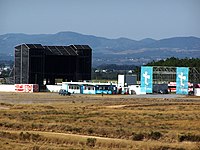
Photo from wikipedia
Glycine soja is a halophytic soybean native to saline soil in Yellow River Delta, China. Photosystem I (PSI) performance and the interaction between photosystem II (PSII) and PSI remain unclear… Click to show full abstract
Glycine soja is a halophytic soybean native to saline soil in Yellow River Delta, China. Photosystem I (PSI) performance and the interaction between photosystem II (PSII) and PSI remain unclear in Glycine soja under salt stress. This study aimed to explore salt adaptability in Glycine soja in terms of photosystems coordination. Potted Glycine soja was exposed to 300 mM NaCl for 9 days with a cultivated soybean, Glycine max, as control. Under salt stress, the maximal photochemical efficiency of PSII (Fv/Fm) and PSI (△MR/MR0) were significantly decreased with the loss of PSI and PSII reaction center proteins in Glycine max, and greater PSI vulnerability was suggested by earlier decrease in △MR/MR0 than Fv/Fm and depressed PSI oxidation in modulated 820 nm reflection transients. Inversely, PSI stability was defined in Glycine soja, as △MR/MR0 and PSI reaction center protein abundance were not affected by salt stress. Consistently, chloroplast ultrastructure and leaf lipid peroxidation were not affected in Glycine soja under salt stress. Inhibition on electron flow at PSII acceptor side helped protect PSI by restricting electron flow to PSI and seemed as a positive response in Glycine soja due to its rapid recovery after salt stress. Reciprocally, PSI stability aided in preventing PSII photoinhibition, as the simulated feedback inhibition by PSI inactivation induced great decrease in Fv/Fm under salt stress. In contrast, PSI inactivation elevated PSII excitation pressure through inhibition on PSII acceptor side and accelerated PSII photoinhibition in Glycine max, according to the positive and negative correlation of △MR/MR0 with efficiency that an electron moves beyond primary quinone and PSII excitation pressure respectively. Therefore, photosystems coordination depending on PSI stability and rapid response of PSII acceptor side contributed to defending salt-induced oxidative stress on photosynthetic apparatus in Glycine soja. Photosystems interaction should be considered as one of the salt adaptable mechanisms in this halophytic soybean.
Journal Title: BMC Plant Biology
Year Published: 2020
Link to full text (if available)
Share on Social Media: Sign Up to like & get
recommendations!